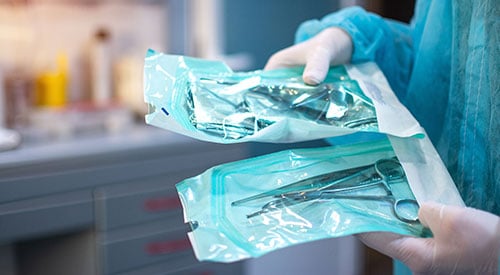
Hydrogen Peroxide Plasma - Cleaning and sterilization • Advantages and applications
Using a vacuum system to dose Hydrogen Peroxide gas and Hydrogen Peroxide plasma to medical and surgical devices has been utilized for sterilization since the late 1980s. When Hydrogen Peroxide is dosed into a plasma machine vacuum chamber the vapor diffuses throughout the chamber and contents. Due to the disinfecting properties of Hydrogen Peroxide vapor followed by plasma generated microbicidal free radicals (e.g., hydroxyl and hydroperoxyl) sterilization can be performed effectively in most materials. Following the sterilization process the chamber can be flushed then vented with filtered air to provide good industrial hygiene for an operator.
A hydrogen peroxide (H2O2) gas sterilizer is a device that applies H2O2 vapors to potentially contaminated surfaces. In principle, hydrogen peroxide can also be used in liquid form to sanitize surfaces, although it has to be diluted in that case. It is commonly applied by healthcare facilities or other institutions that have high standards of hygiene such as the manufacturers of medical devices.
H2O2 vapor is used to sterilize everything, from entire rooms to surgical instruments such as scalpels or endoscopes. Smaller items are usually put into a specially designed chamber and are treated with peroxide. After exposure to the vapors, the microbial load on the surfaces is greatly reduced and the fumes are evacuated from the chamber. H2O2 oxidizes the surface and the microbes, killing them in the process. The byproducts of these reactions are just water and oxygen, which are mostly harmless.
Another positive aspect is that hydrogen peroxide vapors can provide low-temperature sterilization (often between 40 and 100 °C, or 320 to 380 K). Due to the effectiveness in the inactivation of microorganisms, the cycle time of a sterilization chamber is relatively low. It has to be noted that H2O2 acts stronger on so-called gram-positive bacteria than on gram-negative bacteria (however, the latter species is usually more resilient than the former one when it comes to sterilization).
Sterilizing items or entire rooms can be easily achieved with hydrogen peroxide vapors. However, in combination with low-temperature plasma sources, this technology becomes even more potent. Plasma tends to be chemically more reactive, compared to ordinary vapors due to the ions and free electrons within it. This means that the antimicrobial properties are more pronounced. Cold plasma sources can even create H2O2 directly in water, which immediately yields a disinfecting liquid.
For example, a dielectric barrier discharge in water can produce up to 100 µmol of hydrogen peroxide. The H2O2 yield can even be higher if the feed gas contains some water vapor itself. The higher the water content in the air plasma is, the more hydrogen peroxide is created in the plasma. Those reactive molecules can diffuse into cells and cause severe DNA damage to bacteria and other microorganisms, causing them to die quickly.
Water can also be treated with air plasma. This leads to the formation of even higher peroxide concentrations in the liquid. Since hydrogen peroxide plasma has an increased chemical activity, the disinfection cycles can be much shorter compared to neutral gas H2O2 vapor decontamination.
Another upside is that plasma technology can also be combined with conventional hydrogen peroxide disinfection to increase its efficacy. For this purpose, a suitable plasma source is added to a sterilization chamber. The H2O2 vapor is introduced and a low-temperature plasma is ignited, turning the vapor into a partly ionized gas. This enhances the effectiveness of decontamination and brings down the time necessary to get rid of all unwanted microorganisms. The only byproducts of this technique are oxygen and water. Thus, there are no hazardous substances created in the process.
Here is a list of the most prominent differences between conventional sterilization techniques, hydrogen peroxide vapor and plasma with regard to their properties:
Hydrogen peroxide vapor / plasma sterilization provides a safe, non-toxic method of sterilization. It is a dry, non-thermal process that is environmentally friendly and does not produce harmful by-products associated with other methods of sterilization. Objects that are sterilized using vapor phase Hydrogen Peroxide and plasma are completely safe to handle right away because the chamber can be vacuum flushed with filtered air to remove residues left over. This process is most often used on devices or materials that can not endure high temperatures or gamma radiation associated with many sterilization techniques associated with certain plastics, electrical devices and some metal alloys. Most commonly hydrogen peroxide plasma is used to sterilize medical devices and surgical tools.
To learn more about the use of plasma in manufacturing, please read our eBook titled "Manufacturer’s Surface Activation Guide for Improved Adhesion."